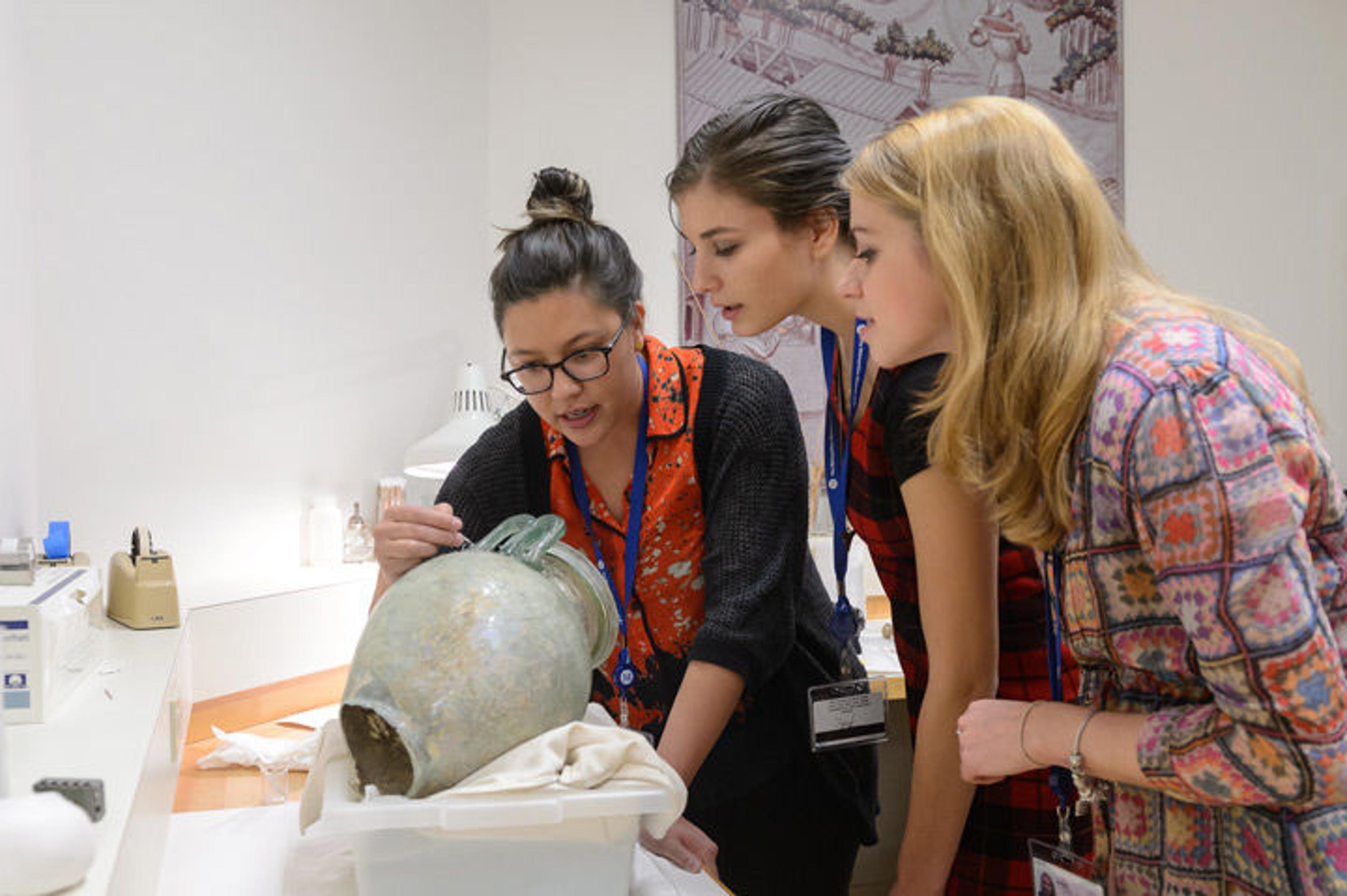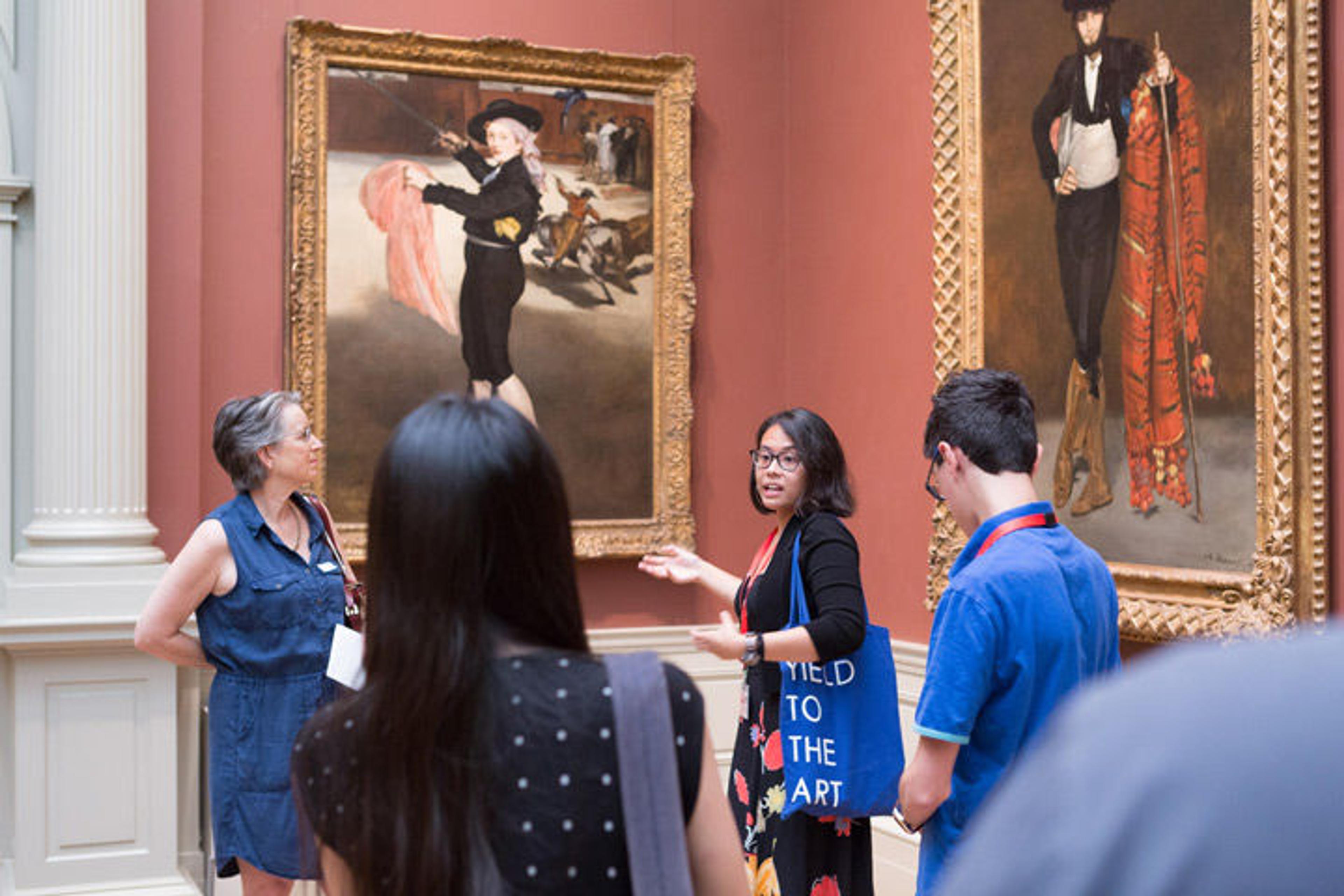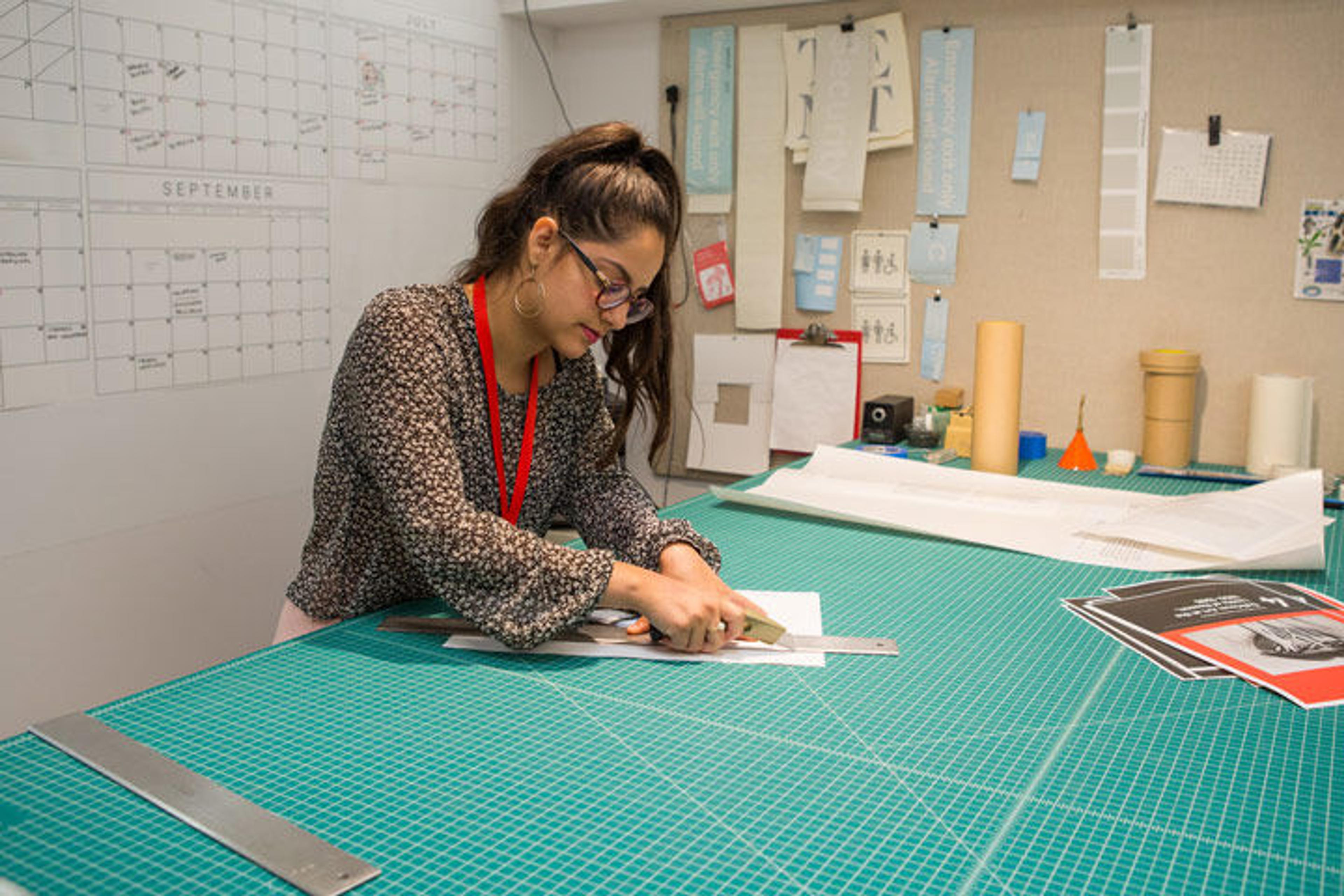
Students observe a conservator at work in the Department of Objects Conservation. Photo by Filip Wolak
«On Friday, November 17, the first Career Insights evening will be held at The Met for college and university students interested in careers in the museum field. It will be an event that goes beyond the traditional talking points and encourages students to jump into discussions directly with Met staff members from a variety of departments.»
The Met's Education Department already offers regular Career Lab events designed for high school students, but it was at the request of a student about to enter the work force (who just happened to be visiting The Met during a Career Lab event) that a special evening was added for emerging young professionals and those already pursuing their undergraduate and graduate degrees. The inaugural Career Insights program will introduce staff with different backgrounds and roles within the Museum through a panel discussion before breakout conversations, which will take place in the galleries. It's an opportunity for students to hear directly from those in the field on when and how their interest in a particular job began, their personal road to The Met, and how one may also work toward a career as a museum professional. The event will also allow students to explore roles within museums that are less familiar and may not be so clearly associated with the "art world." It is open to all undergraduate and graduate students, and Museum admission is included. Register today!
Throughout the evening, more than 40 administrators, curators, conservators, educators, designers, photographers, scientists, writers, and more will share their experiences. Ahead of Friday, a few of the participants provided a glimpse into their careers and some of the unexpected responsibilities of their day-to-day professional lives.
Catherine Stephens, Associate Research Scientist, Department of Scientific Research
What I Do at The Met
I work in the Department of Scientific Research, where my job is to study the environment of the Museum in order to make sure that it is safe for the art. I use analytical instruments and data interpretation to achieve this task. Though I have a PhD in polymer engineering, I have known since I was a teenager that I wanted to work in the field of art conservation. After discovering the sub-specialty of conservation science while working at the National Gallery of Art, I decided to focus on the analysis side instead of the applied side of saving art.
Career Insight
An aspect of my job here that I love is working with the Design and Buildings Departments to help them pick materials to use that are safe for the art, and then seeing how those materials are put to use for exhibitions.
Shadawn Smith, Manager of Government Affairs, Department of External Affairs
What I Do at The Met
Government Affairs is the liaison office between the Museum and all levels of government. We advocate for government funding, monitor legislation like the ban on ivory and the tax-reform bill, as well as creating and maintaining relationships with elected officials. Basically we make sure our friends in government know all the good work our staff does to enhance access and education about the history of art on every level. Equally important, my office handles all community concerns and strengthens relations with residents near all three of The Met's locations.
I previously worked in local government, and The Met was not my ideal next step. I didn't think it was a place for me initially as I am a think-outside-of-the-box kind of person, but I quickly realized it was for that very reason that it was the right next step for me. I love being an example of this Museum as a place for everyone.
Career Insight
My job mixes arts and politics in a unique way. I get to advocate for one of the top U.S. institutions to elected officials and various communities. Really, how cool is that?! In this moment, the Museum sends a powerful message to government and to community members.

A Museum educator speaks with a group of students in the European Paintings galleries during a recent Career Labs event.
James Doyle, Assistant Curator, Department of the Arts of Africa, Oceania, and the Americas
What I Do at The Met
My role as assistant curator of the Art of the Ancient Americas at The Met encompasses three main activities: publishing information about the collection in print and online outlets, especially the online collection, Now at The Met, and the Timeline of Art History; installing the permanent collection in the galleries and continuously updating displays and didactics; and developing special exhibitions that celebrate highlights from the collection and/or ongoing research at the Museum.
As an archaeologist with a doctorate in anthropology, my interest expands from the primary roles of caring for the existing collection to building partnerships with our peer institutions in Latin America—through exhibitions, of course, but also with excavation and conservation projects in the field in Guatemala and Mexico, as The Met has done for a century in Egypt.
Career Insight
Curators are not just behind the scenes. When I began at The Met, I was encouraged to share information about the collection and my activities through Twitter. (Follow me @JamesDoyleMet!) Through social media I have been able to make it possible that people, many of whom may never have the chance to visit the Museum, know about the research we're doing.
Christina Vanech, Program Associate for Accessibility, Education Department
What I Do at The Met
As the program associate for accessibility in the Museum's Education Department, I coordinate both public and by-request programs for visitors with disabilities, including long-term partnerships with organizations. I also assist with internal accessibility and training for staff on disability awareness. I first worked at The Met as a yearlong intern, which gave me the chance to experience the day-to-day environment here firsthand. When a staff position opened up, I jumped at the chance to join the team again.
Career Insight
One aspect of my role as a museum professional that I am excited to share is how much we work together internally. Particularly in such a large museum, it is essential that we collaborate across the institution to ensure that programs run smoothly and that each visitor has a positive experience.
Jessica Glasscock, Research Associate, The Costume Institute
What I Do at The Met
I came to The Met through a circuitous route. When I started college in New York City, I had no plans to work in the arts. I thought I would go into politics, and after college I worked at the American Civil Liberties Union for several years to promote women's rights. When I was deciding whether or not to go on to law school, I saw an exhibition at The Costume Institute. It blew my mind, and I went back to school to go into fashion history, with my eye on being at The Costume Institute specifically all the while. I wanted to devote myself to the visual culture of dress, but always with the idea of being in the public service.
Career Insight
The work is constantly changing according to the needs of any given project. I might be organizing exhibition tours one day, or doing picture research for an exhibition catalogue, or clearing rights for the Museum's use of film clips, or helping to move garment boxes, or learning a new software to facilitate our participation in a digital project. Basically I do whatever needs to be done!

A Met intern getting hands-on experience in the Design Department.
Hannah McHale, Registrar Assistant, Office of the Registrar
What I Do at The Met
In the Office of the Registrar, I make arrangements for hundreds of couriers from all over the world to stay in New York. (Couriers are those who travel with art objects to ensure their safety in transit.) It is wonderful to see how excited couriers are to work on exhibitions at The Met. They often tell great stories and like to pay visits to colleagues as well as their favorite objects in the collection.
Career Insight
Registrars are essentially responsible for moving artwork for exhibitions, loans, acquisitions, etc. Art objects do not simply appear in the galleries—it takes lots of hard work and planning by registrars to get them there—especially large, heavy, and delicate objects! Our department works with all 17 curatorial departments, and we get to see objects from all over the world come in and out of the Museum.
Heather Johnson, Imaging Production Assistant, Imaging Department
What I Do at The Met
As an imaging production assistant in the Imaging Department, the bulk of my responsibility requires working with our staff and other departments to provide photographic and imaging support that helps foster the Museum's mission to create a visually stunning and accurate database of images representing our vast collection. This position requires an extensive knowledge of Photoshop and traditional photographic practices, with an emphasis on studio lighting. I studied photography as an undergraduate and in graduate school, and I arrived at The Met after a year of managing a photo lab in the Soho neighborhood of Manhattan.
The knowledge I gained from working in a studio has been priceless when it comes to retouching studio photography. Understanding how light and objects interact with each other is at the heart of everything we do in Imaging. Even as we move into photogrammetry—a photographic mapping technique that allows for 3D modeling—lighting allows us to recreate textures, geometry, depth, and volume of objects. These imaging techniques help expand the Museum's conservation efforts, enhance exhibitions, and are an important educational tool for researchers and scholars. For students who are interested in pursuing a career in imaging, I would suggest acquiring a strong knowledge of photography, learn as many imaging softwares as possible, and begin to learn about 3D software and modeling because we are only at the beginning of finding ways to incorporate this exciting technology into museum work.
Career Insight
An unexpected aspect of my job that surprised me is the effect of working one-on-one with the various legacies of different artists from the canon of art history. Oftentimes, I get to see how an artist started a project or series from the first scribbles of an idea to the final work of art. Last year, I photographed a collection of ephemera from the collection of fashion designer Charles James, which included his notes, and early sketches that would eventually become fully realized works in his collection. This look into the creative process reminds me how precious and random the act of creating is, not knowing when the germ of an idea will become the final design. Photographing the spark of an idea under the lens of my camera, knowing that this was just the beginning of an artistic journey, is one of the most inspiring parts of my job, which was quite unexpected.
Learn more about the Career Insights event on Friday, November 17, from 5 to 8 pm.